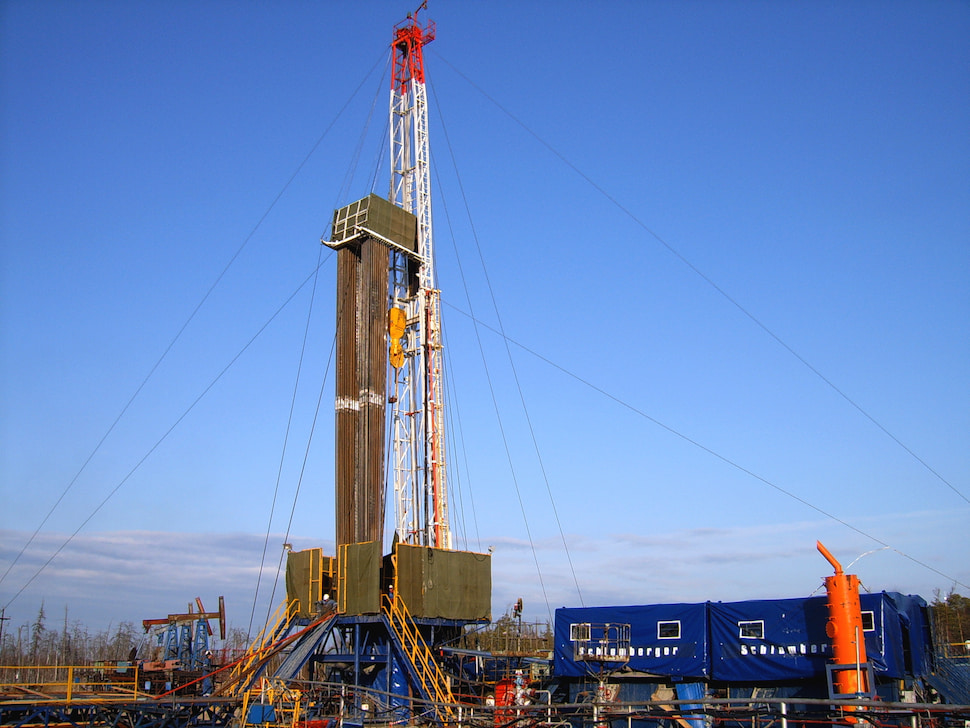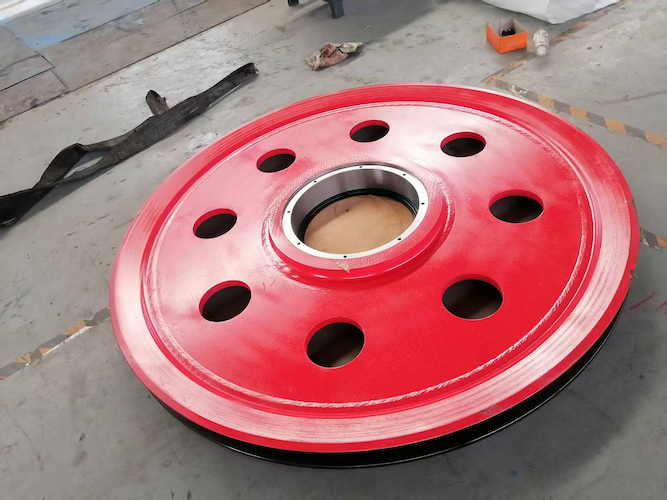أين يتم تطبيق بكرات الرفع؟
Mar 28, 2025
ال بكرات الرفع تشكل جزءًا مهمًا من نظام الرفع لمنصات حفر النفط. بكرات من كتلة التاج وكتلة السفر تُشكّل معًا كتلة بكرة، متصلة بآلية السحب بواسطة حبال سلكية. باستخدام مبادئ كتلة البكرة لتوفير القوة وتغيير اتجاهها، يتم رفع وخفض أدوات الحفر لتلبية احتياجات عمليات حفر النفط. فيما يلي مقدمة ذات صلة:1. البنية والمبدأالهيكل: تتكون بكرة الرفع عادةً من أجزاء مثل جسم البكرة والمحامل، عمود البكرة, وأخدود الحبل. يُصنع جسم البكرة عادةً من فولاذ سبائك عالي القوة أو فولاذ مصبوب لتحمل الأحمال الضخمة. تُركّب محامل على العمود لتمكين البكرة من الدوران بمرونة. يُستخدم أخدود الحبل لاستيعاب الحبل السلكي، ويتوافق شكله وحجمه مع الحبل السلكي لضمان عدم انزلاقه من الأخدود أثناء التشغيل.المبدأ: تُشكّل بكرات كتلة التاج وكتلة الحركة كتلة بكرة، متصلة بآلية السحب بواسطة حبال سلكية. عند الرفع، تُلفّ أسطوانة آلية السحب الحبل السلكي، ومن خلال حركة كتلة البكرة، خطاف منصة الحفر تُرفع أدوات الحفر. عند إنزالها، تنزل أدوات الحفر تحت تأثير وزنها، ويتم التحكم في سرعة إنزال الخطاف بواسطة آلية الكبح والفرامل المساعدة لآلية السحب.2. الوظائفتوفير القوة: من خلال الجمع بين كتلة البكرة، يمكن تحقيق تضخيم القوة، مما يتيح لمعدات السحب رفع أو خفض أدوات الحفر الثقيلة بقوة أقل، مما يقلل من متطلبات الطاقة والقوة الدافعة لمعدات السحب.تغيير اتجاه القوة: يقوم بتغيير اتجاه قوة سحب الحبل السلكي من الاتجاه الأفقي لأدوات السحب إلى الاتجاه الرأسي، والتكيف مع متطلبات الرفع والخفض لأدوات الحفر، ويمكنه نقل القوة إلى الموضع المطلوب.تحسين كفاءة الرفع: يؤدي التشغيل المنسق للعديد من البكرات إلى زيادة عدد دورات لف الحبل السلكي، وتقليل تآكل الحبل السلكي، وتحسين استقرار وموثوقية نظام الرفع، وبالتالي تحسين كفاءة عمليات الحفر.Ⅲ. بكرات كتلة التاجالموقع والوظيفة: تُركّب في أعلى برج الحفر، وهي عبارة عن مجموعة من البكرات الثابتة، وتُمثّل أعلى نقطة في نظام الرفع بأكمله. وظيفتها الرئيسية هي تغيير اتجاه الحبل السلكي ونقل قوة سحب أدوات السحب إلى كتلة الحركة وأدوات الحفر، مما يُمكّن من رفعها وخفضها. عادةً ما يكون هناك عدد كبير من بكرات كتلة التاج، ويختلف عددها وحجمها باختلاف طراز منصة الحفر وقدرة الرفع.الخصائص الهيكلية: تتكون بكرات كتلة التاج عادةً من بكرات متعددة، تُركّب على إطار مشترك أو عمود عجلة. يُحدَّد عدد البكرات وفقًا لعمق الحفر، ووزن الرفع، ومتطلبات تصميم النظام. تشمل التكوينات الشائعة 3، 4، 5 عجلات، إلخ. تُصنع البكرات عادةً من فولاذ سبائك عالي القوة لتحمل قوى السحب الكبيرة والتآكل. تُعالَج أسطحها بمعالجات خاصة، مثل التبريد والطلاء بالكروم، لتحسين صلابتها ومقاومتها للتآكل وتقليل تآكل الحبل السلكي. محامل البكرات هي محامل دوارة عالية الأداء، تتحمل أحمالًا شعاعية ومحورية كبيرة، وتضمن دورانًا مرنًا للبكرات، وتُقلل من مقاومة الاحتكاك.مبدأ العمل: عندما يسحب جهاز السحب بكرة كتلة التاج عبر الحبل السلكي، تدور البكرة حول العمود. بفضل تثبيتها في أعلى برج الحفر، يتغير اتجاه الحبل السلكي، مما يسمح بتوصيله رأسيًا بكتلة الحركة لأسفل، مما يحول قوة السحب الأفقية لجهاز السحب إلى قوة سحب رأسية لرفع أدوات الحفر.Ⅳ. بكرات كتلة متحركةالموقع والوظيفة: تقع بكرات كتلة الحركة أسفل كتلة التاج، وهي بكرات متحركة. تتصل بكتلة التاج عبر حبال سلكية، كما تتصل بالخطاف الذي يُعلق أدوات الحفر. وظيفة بكرات كتلة الحركة هي التعاون مع بكرات كتلة التاج لإتمام عمليات الرفع والخفض والتعليق لأدوات الحفر. وفي الوقت نفسه، أثناء عملية الرفع، تتشارك البكرات قوة سحب الحبل السلكي، مما يُخفف الحمل الذي تتحمله البكرة الواحدة.الخصائص الهيكلية: يتشابه هيكل بكرات كتلة الحركة مع هيكل بكرات كتلة التاج، وهي أيضًا كتلة بكرات مكونة من بكرات متعددة. تتطابق موادها وطريقة تصنيعها وطريقة معالجتها السطحية بشكل أساسي مع بكرات كتلة التاج، مما يحقق نفس متطلبات القوة ومقاومة التآكل. يجب أن يراعي تصميم هيكل كتلة الحركة اتصالها بالخطاف وثباتها العام لضمان سلاسة التشغيل أثناء رفع وخفض أدوات الحفر وتقليل الاهتزاز والتأرجح.مبدأ العمل: في عملية الحفر، يدور الحبل السلكي حول بكرة كتلة التاج وبكرة كتلة الحركة لتشكيل نظام مغلق. عندما تسحب وحدة السحب الحبل السلكي، تدور بكرة كتلة التاج وبكرة كتلة الحركة في وقت واحد. ولأن كتلة الحركة تتحرك صعودًا وهبوطًا على طول قضبان توجيه برج الحفر، فإنها تُحرك الخطاف وأدوات الحفر رأسيًا. أثناء عملية الرفع، تتشكل خيوط حبال متعددة بين كتلة التاج وبكرات كتلة الحركة، ويشارك كل خيط حبل جزءًا من وزن أدوات الحفر، مما يُقلل من قوة السحب التي تتحملها كل بكرة، ويُحسّن سلامة وموثوقية نظام الرفع بأكمله.Ⅴ. لاختيار بكرات التاج والكتل المتحركة المناسبة لعمليات حفر النفط المحددة، يجب مراعاة العوامل المتعددة التالية بشكل شامل: عمق الحفر: يؤثر عمق الحفر بشكل مباشر على قوة الرفع المطلوبة وطول الحبل السلكي. بشكل عام، كلما زاد العمق، زادت قوة الرفع المطلوبة، ويجب اختيار بكرات ذات قدرة تحمل أعلى. في الوقت نفسه، قد يلزم أيضًا أن يكون حجم البكرة أكبر لاستيعاب حبل سلكي أطول. على سبيل المثال، لحفر الآبار العميقة جدًا، قد يلزم استخدام بكرات ذات قطر كبير وقوة عالية لتلبية متطلبات الرفع.وزن الرفع: احسب بدقة أقصى وزن للرفع، بما في ذلك أدوات الحفر، وأنابيب التغليف، وسائل الحفر، وغيرها. اختر بكرات تتحمل الحمل المناسب وفقًا لهذا الوزن. عادةً، يجب أن يكون الحمل المقدر للبكرة أكبر من الحد الأقصى لوزن الرفع بمقدار 1.2 إلى 1.5 مرة لضمان هامش أمان. على سبيل المثال، إذا كان الحد الأقصى لوزن الرفع 200 طن، فيجب أن يتراوح الحمل المقدر للبكرة بين 240 و300 طن.مواصفات الحبال السلكية: يجب أن تتوافق مواصفات الحبال السلكية المختلفة مع بكرات بأحجام وأشكال أخاديد متناسبة. يجب أن يكون قطر أخدود الحبل في البكرة مناسبًا لقطر الحبل السلكي. عادةً، يكون قطر أخدود الحبل أكبر من قطر الحبل السلكي بمقدار 1 إلى 2 مم لضمان تثبيت الحبل السلكي جيدًا في أخدود الحبل وتقليل التآكل والانزلاق. في الوقت نفسه، يجب أن تلبي سعة البكرة متطلبات طول الحبل السلكي أثناء عملية الحفر.بيئة العمل: إذا أُجريت عملية الحفر في ظروف عمل خاصة، مثل درجات الحرارة والرطوبة العالية والبيئات المسببة للتآكل، أو في المناطق البحرية، فيجب اختيار بكرات ذات أداء وقائي مناسب. على سبيل المثال، في المنصات البحرية، يجب أن تتمتع البكرات بمقاومة جيدة للتآكل، ويمكن استخدام مواد من الفولاذ المقاوم للصدأ أو بكرات مُعالجة بطلاءات مضادة للتآكل. في البيئات ذات درجات الحرارة العالية، يجب اختيار محامل ومواد تشحيم مقاومة لدرجات الحرارة العالية لضمان التشغيل الطبيعي للبكرات.سرعة الحفر: كلما زادت سرعة الحفر، زادت قدرة البكرة على تحمل الصدمات والتآكل. لذلك، يجب اختيار بكرات ذات دوران مرن ومقاومة جيدة للتآكل. يمكن تصنيع البكرات باستخدام محامل عالية الدقة ومواد عالية الجودة مقاومة للتآكل لتلبية متطلبات الحفر عالي السرعة.مساحة برج الحفر: يحدّ حجم مساحة برج الحفر من حجم كتلة التاج وكتلة الحركة، مما يؤثر على اختيار البكرات. بناءً على ارتفاع برج الحفر وعرضه وقدرته على التحمل، يُنصح باختيار بكرات ذات حجم وهيكل مناسبين لضمان إمكانية تركيبها وتشغيلها بشكل معقول داخله دون التسبب في تحميله بشكل زائد.الاقتصاد: لتلبية متطلبات عملية الحفر، يجب مراعاة تكلفة البكرات وعمرها الافتراضي وتكاليف صيانتها. اختر بكرات عالية الأداء لتقليل التكلفة الإجمالية لعملية الحفر. على سبيل المثال، على الرغم من أن بعض البكرات المستوردة عالية الجودة أغلى ثمناً، إلا أنها تتميز بعمر افتراضي أطول وأداء أفضل، وقد تكون أكثر اقتصادية على المدى الطويل. في حين أن بعض البكرات المحلية منخفضة السعر نسبياً، ويمكن إعطاؤها الأولوية إذا كانت تلبي متطلبات التشغيل.العلامة التجارية والجودة: اختر بكرات من علامات تجارية معروفة وذات جودة موثوقة لضمان أدائها وسلامتها. تخضع بكرات العلامات التجارية المعروفة عادةً لفحوصات جودة صارمة وشهادات اعتماد، وتتميز بثبات وموثوقية أفضل، ويمكنها تقليل حوادث الحفر ووقت التوقف الناتج عن أعطال البكرات. يمكنك الرجوع إلى تجارب الاستخدام وتقييمات مشغلي الحفر الآخرين لاختيار العلامات التجارية والطرازات المناسبة.Ⅵ. الصيانةالتفتيش اليومي: قبل وبعد كل يوم عمل، تحقق مما إذا كانت هناك شقوق أو تآكل أو تشوه على سطح البكرة، وما إذا كانت تدور بمرونة، وما إذا كان موضع الحبل السلكي في أخدود الحبل طبيعيًا.التزييت المنتظم: اختر شحم التزييت المناسب. وفقًا لدليل تعليمات الجهاز وظروف التشغيل الفعلية، قم بالتزييت مرة كل 100 إلى 200 ساعة عمل أو مرة واحدة أسبوعيًا. عند حقن الزيت، تأكد من ملء شحم التزييت بالكامل في أجزاء المحمل والمقود.التنظيف والصيانة: أزل الشوائب بانتظام، مثل بقع الزيت والغبار وسوائل الحفر، من سطح البكرة. فكّ البكرة ونظّفها بانتظام، ثم نظّف بقع الزيت والشوائب الداخلية، وجفّفها، ثم أعد تركيبها وأضف شحم التشحيم.الكشف والمعايرة الدورية: استخدم أدوات قياس احترافية لقياس أبعاد أخدود ومحور حبل البكرة بانتظام، ومراقبة حالة التآكل، واستبدال البكرة في الوقت المناسب عند وصول مستوى التآكل إلى الحد الأقصى. عاير كتلة التاج وكتلة البكرة المتحركة بانتظام للتأكد من أن جميع البكرات في نفس المستوى، وأن استواء البكرات وعموديتها يلبيان المتطلبات.
اقرأ أكثر

